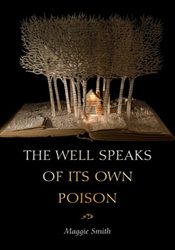
Maggie Smith’s second full-length collection is a both a warning and an enchantment. Drawn from the Brothers Grimm and Hispanic folktales, the ominous, magical poems in The Well Speaks of Its Own Poison inhabit the dark forests of fairytale as well as suburban neighborhoods where “The kids/named the cul-de-sacs.”
The book’s opening poem beckons us off the forest path, following a girl who “does not know/ wickedness when she sees it” into a dangerous, mythic landscape. Luckily, the poem’s speaker is far wiser than its heroine, aware of every old fable the girl may be reliving: “What is she doing alone?/ Gathering nosegays? Using her mother’s disregard/ to hack through the brambles?” With spare, haunting imagery, the speaker warns us how easily the self can disappear, can be consumed:
The girl is lost, not hunted. Taken, but not into a hot,
dark mouth. Nothing lurks in the fir’s blue pins.
Swallowed whole by trees, eaten alive in a manner
of speaking, she walks toward a point none of us can see.
It is blacker there than in the gut. From far off, her life
rings like a thrown voice. Let it not be a fable for others.
-“Vanishing Point”
And so the reader is warned—and captivated. Smith’s lyrical voice is precise, never pretentious, in its magical realism. She is what Clarissa Pinkola Estés PhD calls a “cantadora, a keeper of the old stories,” in the 1990s feminist book of myths, Women Who Run With the Wolves. Dr. Estés unfolds intercultural tales that restore women’s creative vitality by “dig[ging] into the ruins of the female underworld,” exploring the archetype of the Wild Woman, the instinctive psyche. Smith delves into this underworld as well, but in her gorgeous and terrible dreamscapes, the psyche is always in peril:
No one is out of danger.
Darkness threads a needle as fast as light. As the devil eats,
bones pile under the table. Bread cries out in the oven
for fear of burning. A heart nestles among red apples.
-“Village Smart”
These poems are studded with images we recognize from fairytales, offering iconic color in the forest gloom: wolves, foxes, deer, skinned rabbits, apples, hearts, white bones. Through Smith’s imaginative leaps, a kind of sorcery occurs, the lines shape-shifting quickly and musically: “Even a fox with blood on its muzzle/ can wish on red clover and be a girl again” (“Apologue (3)”).
Shape-shifting and transformation heighten in the eight “Apologues,” fantastical poems that originate, Smith tells us in a note, from Tales Our Abuelitas Told: A Hispanic Folktale Collection. Always spoken in the second person singular,” the Apologues create a strange intimacy with the reader:
Little Twig Snapping
Under the Devil’s Shoe, for every crow’s heart you swallow
whole, you are promised a gold piece under your tongue.
Now coins fall from your lips when you speak, chiming
around you, but they might as well be pebbles. The pearls
you weep might as well be tears.
-“Apologue (5)”
The Apologues are the most lush, wild, and lyrical poems in The Well Speaks of its Own Poison, balancing the stark horror of the other fairytale world, where humans are hunted without mercy:
Gaunt and salt-and-pepper as the birches, the wolves
are starving in these woods. From here the moon
is a crystal ball. I don’t need to look inside
to tell you that if you walk into the trees,
you won’t come out.
-“The Fortune Teller to the Woodsman”
This poem is saved from brutality by the sheer beauty of its violence, something stunning and redemptive in the hunger:
If the moon says
you’ll be picked clean, believe her. You’ll feed
whatever hunts you the heart hot from your body.
Many voices issue warnings in The Well Speaks of its Own Poison: not only the Fortune Teller to the Woodsman, but mother to child, sister to sister, even “the robotic voice of a school bus” depositing children on the sidewalk, and the stone well of the title, poisoned by envy, which cautions “Who drinks of me/ now will be a tiger, then a wolf, then a roebuck.” In a world where a girl’s hands may be severed, the ability to speak is of utmost importance, generating power and integrity. Women, especially, must tell their stories. So warns the vigilant mother in “If I Forget to Tell You”: “Daughter,/ where silence is permitted to grow, it grows.”
The Well Speaks of its Own Poison renders a tapestry of stories, fables, and parables, and in the process explores the act of story-telling and revision. In “Unclassified Stars,” Smith’s incestuous re-telling of Hansel and Gretel, Grimm’s original version transforms into an experience of self-discovery and sensual awakening, a secret love story. Written in five sections, the prose poem keeps switching details, changing scenes, reinventing itself until the final stanza, narrated by Gretel:
Ultimately, all revisions of her life collapse into one: the sharpening sea, the candied eaves of the cottage, Hansel’s salty fingers in her mouth. At the end of the story, where the moral should be, there are only two nudes reclining, naked and flushed beneath a great oak. Babes in the wood. Who’s to say where one ends and the other begins? Where the body forgets its edges. Where the story drops off and calls itself memory, life. Who’s to say? They have been rolling so long in the leaves, their two skins smell exactly the same.
-“Unclassified Stars”
At the end of this collection, where the moral should be, we are left with impressions of great beauty and great danger, a passionate waking dream.




